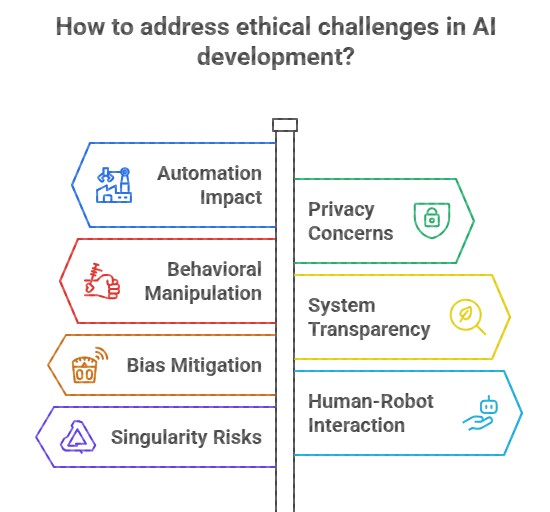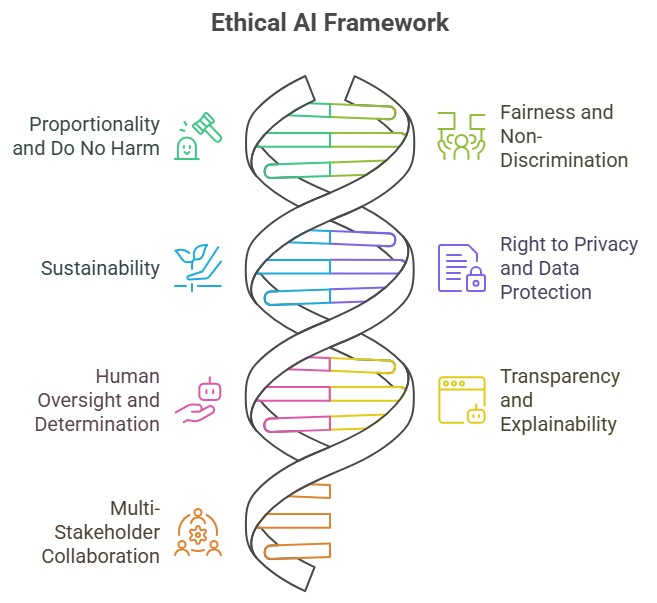Explore ethical issues of AI: autonomous car responsibility, privacy, bias, manipulation, singularity & human-robot interaction. Learn UNESCO’s AI ethics principles—fairness, transparency & accountability—for building a human-centered AI future.

Recent Incident: Elon’s car was caught on camera ramming into another car. But he pleaded not guilty. His argument was that his car was in autonomous mode, so the responsibility of the accident lies with the car manufacturer.

Every day, new use cases of AI are emerging, it would be impossible to potentially foresee every possibility. To overcome this issue, 193 countries at UNESCO have collectively finalized following design principles for ethical use of AI-

|
Biased AI |
|||
|
Gender biasness |
Ethical dilemma involved in choosing a decision |
Absence of responsibility and accountability norms for Machines/Robots |
Efficient but Unpredictable use of AI |
|
Ex.– If we search the “greatest player of all Time”, then the search engine will provide the list of prominent male personalities |
Ex. Autonomous Car – Imagine an autonomous car with broken brakes going at full speed towards a grandmother and a child. By deviating a little, one can be saved |
Ex. AI creates Art - Ex. Who will be designated as author? The company which orchestrated the project, the engineer, the algorithm or we all as a collective race? |
Ex. AI in the court of law: – The use of AI in judicial systems around the world is increasing. AI could presumably evaluate cases and apply justice in a better, faster and more efficient way than a judge. But will it uphold human rights and fundamental values? |
Some ethical questions are about mitigating suffering, some about risking negative outcomes. While we consider these risks, we should also keep in mind that, on the whole, this technological progress means better lives for everyone. Artificial intelligence has vast potential, and its responsible implementation is up to us. We need a human-centred AI.


Refine your answer writing skills and elevate your UPSC preparation with personalized support and expert feedback.
Fill out the form to get started with the program or any other enquiries !








Are you dreaming of becoming an IAS officer? Then, IAShub can be your best guide. It is one of the Best IAS Coaching in Delhi. Many students who want to clear the UPSC exam join IAShub for learning. The institute gives both online and offline classes. Their teachers are experienced and helpful. They easily explain every topic. Students also get notes, tests, and tips to do well in the exam.
IAShub is in Delhi and is trusted by many UPSC students. It offers coaching for every part of the UPSC exam – Prelims, Mains, and Interview. The classes are simple and easy to understand. The teachers are experts and guide students in the right way. IAShub is also known for its helpful notes, test series, and answer-writing practice. IAShub is the best coaching in Delhi and also gives UPSC Online Classes. This helps students from any place in India to learn. The online classes are live and also recorded. So, students can watch them anytime. These classes cover the full UPSC syllabus.
Here are some important services provided by IAShub:
The UPSC Civil Services Exam has three parts:
This exam is tough, but with the right guidance, it becomes easy to manage. Students must study smart and stay regular.
IAShub supports students from the beginning to the end. It gives the right books, tests, and notes. The classes are easy to follow, and the teachers are always ready to help. Students get personal doubt sessions too. The test series and answer checking help students learn where they need to do better. Also, free study materials save time and money.
IAShub also guides students during the final stage – the interview. Experts take mock interviews and give useful tips. This full support makes IAShub one of the best IAS coaching in Delhi.